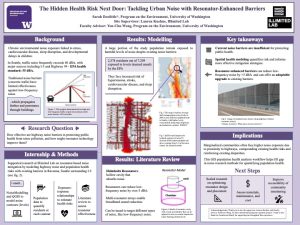The Hidden Health Risk Next Door: Tackling Urban Noise with Resonator-Enhanced Barriers
Traffic and highway noise is a critical but often overlooked public health issue, linked to sleep disruption, cardiovascular disease, and impairments in cognitive development in children. Exposure is unevenly distributed, with low-income and marginalized communities being disproportionately impacted, making noise pollution both a health risk and an environmental justice concern. Mitigation of highway noise is typically through construction of barriers, when impacted areas meet criteria for abatement. But these barriers are limited in effectiveness, particularly against low-frequency noise, leaving many urban communities exposed to harmful noise levels. This study aimed to evaluate the effectiveness of existing highway noise barriers and explore resonators, which are structural cavities that can be tuned to absorb low-frequency sound waves that these barriers fail to block, as an innovative solution to improve noise mitigation. As part of my internship with Illimited Lab at the University of Washington, I used GIS and NoiseModelling software to simulate highway noise exposure in a Seattle neighborhood around I-5 with current barrier infrastructure. By integrating demographic data and established noise-dose response relationships, I quantified population health risks, identifying substantial exposure to noise levels associated with stroke, heart disease, and learning impairments, despite existing sound barriers. To address these limitations, I conducted a literature review to support ongoing research at the Illimited Lab about resonator technology that indicated resonators can improve noise reduction by over 5 decibels at targeted frequencies. Integrating resonator technology into highway infrastructure could significantly reduce noise exposure and improve public health outcomes in urban communities.
